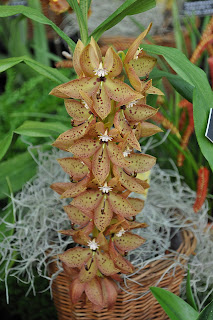








































This weekend we participated in our town’s Green Home & Garden Tour by opening up our yards to our neighbors. Each participating home highlights one or more features, e.g improved home heating/cooling efficiency, decreased wasted electricity consumption, solar power, tankless water heater, wood pellet stoves, sustainable gardening techniques, water conservation efforts, stormwater runoff management, etc…
Roughly 30 families toured our yard, which kept our dog, Sebastian, busy greeting and socializing while we led overlapping tours. Many visitors are new homeowners out to meet their new neighbors in the community and get ideas of what problems commonly exist in our town's homes, how people solve such problems, and what types of plants work in our climate.
Shortly after moving into our home, we had a home energy audit performed to prioritize the upgrades and alert us to other potential problems. We've improved door and window weatherization, installed energy efficient windows, increased attic insulation (from R-9 to R-49), installed an attic tent to keep heat and conditioned air escaping into the attic, and installed attic ventilation along the eaves and roof ridge.
In the front and back yards, we’ve practiced turf reduction. My partner’s assertion is that turf grass does relatively little to slow stormwater or support wildlife. My reason is that I don’t like to mow the lawn. But, when mowing is necessary, we use a push reel mower rather than a gas or electric mower.
To help manage stormwater, from our house and run-off from our neighbors’ yards, we’ve installed rain barrels, which are especially useful to get us through the late Summer drought, moved the clay around to create berms slowing erosion, installed a sun and water-tolerant terrestrial orchid bed on the sunnier side of the property where stormwater flows, and a bog (partially based on plants which would be found in a Prince George's county, MD Magnolia bog such as cinnamon fern, royal fern, and Pennsylvania sedge) on the shadier side of the property where stormwater flows.
Here's a pic of Bletilla striata, now in bloom in the sunny orchid bed.
In addition to turf reduction, we’ve practiced edible and native landscaping. The edible landscaping comprises a fig tree, paw paw trees, American hazelnut trees, dwarf apple trees, dwarf cherry trees, east coast native Prunus maritima (beach plum), raspberries, blackberries, blueberries (high- and low-bush), cranberries, elderberry bushes, kiwi vines, grape vine, Jerusalem artichoke (sunchoke), rhubarb, strawberry (ground cover), creeping thyme (ground cover), asparagus beds, and multiple herb and vegetable garden beds.
Here's a pic from Saturday morning's harvest...

The native landscaping comprises plants that provide nectar for pollinators, berries for birds and mammals, and butterfly larval host plants, such as buttonbush, Ilex verticillata (winterberry trees), various ferns, milkweeds, native grasses, asters, goldenrods, violets, helianthus (sunflowers), Virginia creeper, Mayapples, Liatris, Callicarpa, Rhus aromatica (sumac bush) and Rhus copalinum (sumac tree).
Okay, so what does the Green Tour have to do with Cymbidiums? Well, my shadeframe is an obvious structure in the back yard, and it did not go unnoticed because Cym. Kusuda Shining 'Bold One' was in full bloom with four spikes of colorful and fragrant flowers.















